Apple iPad 2 GPU Performance Explored: PowerVR SGX543MP2 Benchmarked
by Anand Lal Shimpi on March 12, 2011 3:04 PM EST- Posted in
- Smartphones
- Apple
- iPad
- GLBenchmark
- iPad 2
- Mobile
- Tablets
GLBenchmark 2.0
GLBenchmark 2.0—as its name implies—tests OpenGL ES 2.0 performance on compatible devices. The suite includes two long benchmarking scenarios with a demanding combination of OpenGL ES 2.0 effects - texture based and direct lighting, bump, environment, and radiance mapping, soft shadows, vertex shader based skinning, level of detail support, multi-pass deferred rendering, noise textures, and ETC1 texture compression.
GLBenchmark 2.0 is the best example of an even remotely current 3D game running on this class of hardware—and even then this is a stretch. If you want an idea of how the PowerVR SGX 543MP2 stacks up to the competition however, GLBenchmark 2.0 is probably going to be our best bet (at least until we get Epic to finally release an Unreal Engine benchmark).
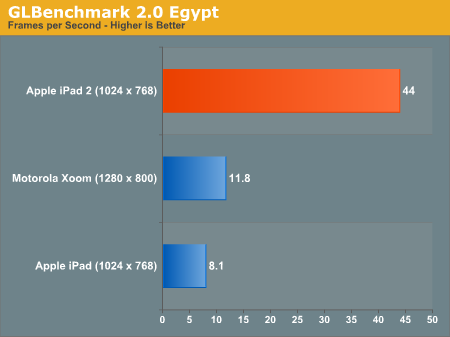
Without AA, the Egypt test runs at 5.4x the frame rate of the original iPad. It's even 3.7x the speed of the Tegra 2 in the Xoom running at 1280 x 800 (granted that's an iOS vs. Android comparison as well).
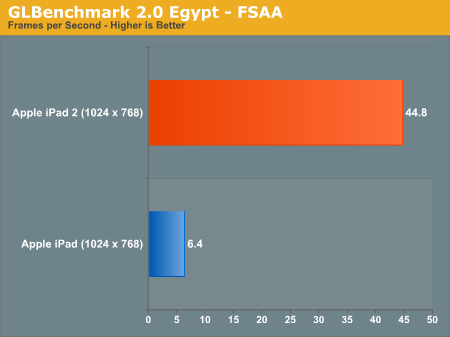
With AA enabled the iPad 2 advantage grows to 7x. In a game with the complexity of the Egypt test the original iPad wouldn't be remotely playable while the iPad 2 could run it smoothly.
The Pro test is a little more reasonable, showing a 3 - 4x increase in performance compared to the original iPad:
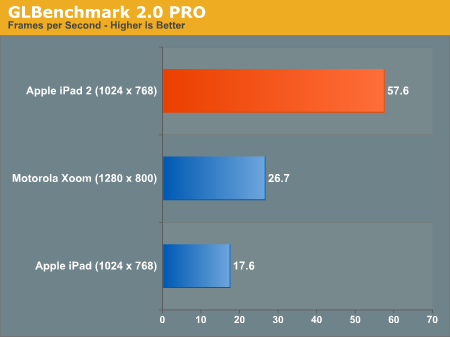
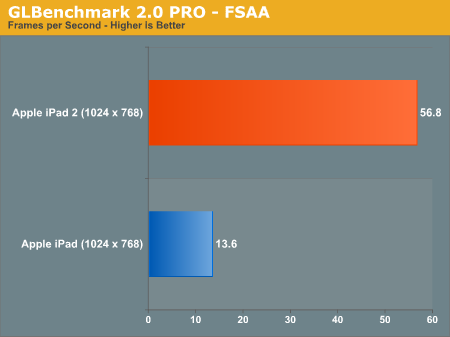
While we weren't able to reach the 9x figure claimed by Apple (I'm not sure that you'll ever see 9x running real game code), a range of 3 - 7x in GLBenchmark 2.0 is more reasonable. In practice I'd expect something less than 5x but that's nothing to complain about. We'll be doing power analysis over the weekend so expect more detail in our full review.
Putting the PowerVR SGX 543MP2 to Use: Infinity Blade
As we pointed out in our iPad 2 Preview, at least one developer already picked up on the amount of extra GPU horsepower in the new iPad 2. Epic put out an updated version of Infinity Blade with support for the iPad 2. Run it on an iPad and you'll get the same old Infinity Blade, but run it on an iPad 2 and you'll get more detail, higher resolution textures and anti-aliasing.
Remember that iPad and iPhone devices are more closed than your PC. There's no adjusting detail settings or resolution, so the target frame rate is usually what's fixed. Developers are simply able to deliver a better looking experience at roughly the same frame rate with upgraded hardware. In the case of Infinity Blade, load times are reduced thanks to the Cortex A9 CPU cores and there is some improvement in frame rate but the biggest impact comes from the improved visuals.
Below is the comparison beween Infinity Blade on the iPad and iPad 2 we ran in this morning's preview:
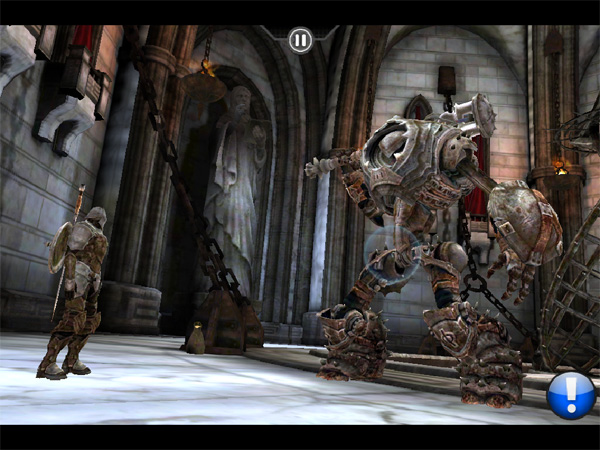
Mouse over to see Infinity Blade on the iPad 2
There's far more detail in the character models as well as the environment. Lighting looks improved and the AA is definitely appreciated.
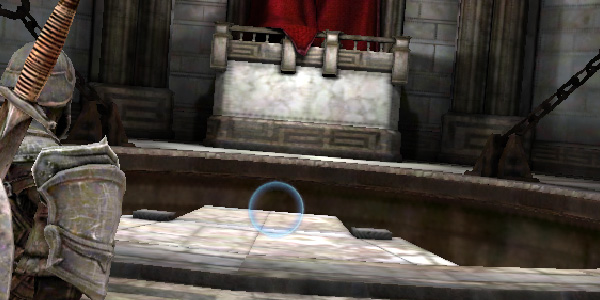
Mouse over to see Infinity Blade on the iPad 2
The gallery below has a bunch of side by side shots showing the improvements made to Infinity Blade for the iPad 2 vs. what you get when you run the game on a first generation iPad.
To Be Concluded...
We're still hard at work on our full iPad 2 review. We've got no less than four units running through battery life tests right now and there's still more to talk about in the review. We'll keep you posted, thanks for reading!


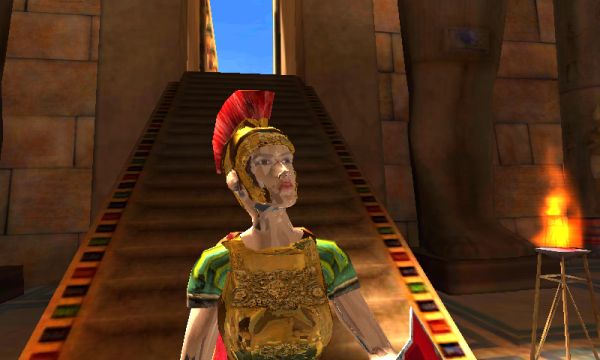














219 Comments
View All Comments
djgandy - Sunday, March 13, 2011 - link
^^^ What he said.The same applies on Windows when applications create 640x480 windows. The rendering space is smaller due to window borders.
runner50783 - Sunday, March 13, 2011 - link
Stop your trolling! I don't see any favoritism here and never has on any of Anantech's reviews, tell that to Engadget, Gizmodo and the like.I did not expected anything less than this kind of detailed scrutiny on such an important device, plus due to the lack of true technically educated reviewers for Apple hardware Anandtech has become sort of the reference review site for this devices, a title that if I were Anand, will do what ever I can to keep.
eXces - Saturday, March 12, 2011 - link
it turned out to be an incredible device, i think i will give my iPad to my daughter and buy the iPad 2ltcommanderdata - Saturday, March 12, 2011 - link
Thanks for the quick test on graphics performance ahead of your iPad 2 full review.I noticed that in the Egypt and Pro benchmarks, the frame rate with FSAA is actually the same or higher than without FSAA for the iPad 2. Could you comment on why that would be? I would guess that the SGX543MP2 without FSAA it's purely shader ALU limited, while with FSAA there is dedicated AA hardware so shader performance is not impacted and the A5 has lots of extra memory bandwidth or the SGX is very memory bandwidth efficient so that is not a limitation.
And for the Inifinity Blade comparison, would it be possible to post iPhone 4 shots as well? I believe the higher resolution textures, bump mapping, and specular shaders were already in place in the iPhone 4 version. AA did seem enabled in the iPhone 4, but perhaps only 2x since the iPad's AA looks higher/better.
rish95 - Saturday, March 12, 2011 - link
It probably has a lot of memory bandwidth.I'm guessing:
800 MHz LPDDR2?
metafor - Monday, March 14, 2011 - link
Tile-based rendering suffers little to no loss from AA implementations due to their early throwaway nature.stm1185 - Saturday, March 12, 2011 - link
Surpised how faster it is then the Tegra 2. Even if you factor in the resolution disparity, with the Xoom having about 25% more pixels, it still is really impressive.dj_aris - Saturday, March 12, 2011 - link
You know what would be interesting? To see the exact same benchmarks on a PC GPU. How do these tablets perform against some real Nvidia or ATI hardware? Or even some Intel integrated GPU? And to take it even further, are they more capable than a handheld game console (PSP / DS)?ET - Saturday, March 12, 2011 - link
This is way more powerful than the PSP and 3DS (DS is so underpowered anything would beat it). I agree it'd be interesting to put it in perspective with current and past PC cards and with consoles (well, it'd beat the Wii, but I wonder how far it has to go to catch up to the PS3 and Xbox 360).I believe that a year or two from now phones (and certainly tablets) would be able to drive 720p or even 1080p high quality games. Hook one to a TV, link a controller via bluetooth and you'd have a real console that would compete with current ones (with enough leftover CPU power to let you answer calls via a bluetooth headset while you're playing).
rquick - Sunday, March 13, 2011 - link
You say that the handheld should compete with the consoles in a year or two, but the consoles are also going to take a generation leap in the near future. We might see the next generation xbox and ps sometime next year - my fingers are crossed. From looking at the numbers, I would have to guess that the current xbox is already 6-8 times more powerful than the ipad2. Just a guess, but I would also bet that is overly conservative. The next leap in console graphics should be enormous by comparison since their expected life cycle could be 5 years or more. Once that happens, I don't think the ability to compete with the current (old) consoles would be very a big selling point for a device that costs more than the new console. Again. just a guess on prices, but I think Sony proved that consoles won't sell at $600.